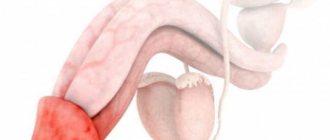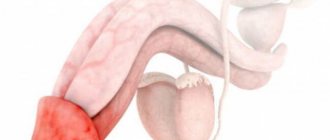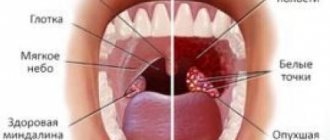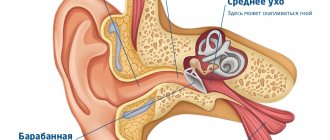A spasm in the throat is a complaint that can cause panic in the patient. Symptoms range from discomfort when swallowing to choking. Its pathological substrate is a sharp narrowing of the lumen of hollow organs located in the neck (pharynx, larynx, esophagus).
Some cases end in death, so this condition cannot be ignored or self-medicated.
A spasm in the throat is a symptom, under the mask of which several pathologies are hidden. Therefore, there is no universal method for eliminating it.
The cause of this complaint directly determines how the doctor will treat a throat spasm in a particular patient. Consultation with more than one specialized specialist may be required.
Causes of spasm in throat
Spasms are distinguished:
- Situational. A sharp muscle contraction is provoked by external causes.
- Endogenous. Caused by internal factors. For example, we are talking about the presence of a concomitant disease in a person.
Situational spasms in the throat are caused by the following reasons:
- Inhalation of air containing irritating substances.
- Use of medications with spasmogenic side effects.
- Stressful situations, excessive emotional and physical stress, even severe sharp pain.
- Sloppy eating.
- Interaction with any source of allergens.
The main groups of pathologies that can cause muscle spasms in the throat area:
- Diseases of the endocrine system (damage to the thyroid and parathyroid glands).
- Psychoneurological disorders (hysteria).
- Upper respiratory tract infections (common causes are laryngitis, acute tonsillitis, pharyngitis).
- Vascular pathology (condition after a stroke).
- Diseases of the gastrointestinal tract (reverse reflux of hydrochloric acid with reflux esophagitis).
- Oncopathology (irritation of the nerve endings of the muscles by large tumors).
- Diseases of the musculoskeletal system (muscle spasm of the pharynx and esophagus due to hernia of the cervical spine).
Segmental spasm
Esophageal spasm - a feeling of tightness
If spasms appear in some areas of the cavity and their intensity is high, this is a segmental spasm, its symptoms:
- Dysphagia while drinking.
- The duration of the spasm is up to four hours.
- The pain accompanying the spasm begins gradually and fades slowly.
- Difficulty swallowing fiber-rich foods.
With cardiac spasm, the esophageal tube is expanded equally along its entire length, while the cardiac segment is narrowed.
Cardiospasm can be caused by various diseases of organs located near the esophagus - pleurisy, aortic aneurysm.
The second reason is infectious diseases (poliomyelitis, diphtheria and others), which lead to disorders of the central nervous system.
Problems with the esophagus can arise due to peptic ulcers of the stomach or esophagus, injuries, neoplasms, including malignant ones, poisoning with alcohol, chemicals and smoking.
Spasms can be caused by osteochondrosis of the cervical spine when nerve endings are pinched. Symptoms of osteochondrosis are very similar in appearance to a number of other diseases, and therefore require careful diagnosis.
Main and accompanying symptoms
Spasms in the throat can manifest themselves in the form of the following main symptoms:
- Breathing problems. The degree can range from mild difficulty in breathing (inspiratory dyspnea) to a feeling of suffocation. Inhalation of air is accompanied by noise, sometimes a slight whistle and a barking cough (in a child).
- Feeling of a lump or foreign body in the throat. The patient is unable to quickly get rid of it; drinking water does not always help. Throat spasms may become worse when swallowing.
- Pain syndrome. Caused by pathological tension of the cervical muscles. Light pressure on the throat may increase spasm and pain.
Cramps due to eating
Eating certain foods causes a sharp contraction of the muscles of the pharynx and esophagus. The cause of spasms in the throat can be a large lump of hard, dry food.
Accidental ingestion of sharp bones also leads to esophageal obstruction.
Errors in nutrition play an indirect role in reflux disease: eating spicy, fatty foods is a factor in increasing the acidity of gastric juice.
In a patient suffering from this disease, hydrochloric acid is partially released into the esophagus. The contents of the stomach irritate the walls of the organ and cause them to contract sharply, which feels similar to the feeling of a lump when swallowing.
A gastroenterologist decides how to relieve unpleasant spasms in the throat with reflux esophagitis.
Diffuse spasm
Feeling of a lump in the throat
The muscles located along the entire length of the esophagus contract involuntarily, while the lower sphincter maintains normal tone.
The symptoms are pronounced - severe pain behind the sternum and in the area of the junction of the esophagus and stomach, pain can reach the lower jaw and radiate to the shoulder. Occurs regardless of food intake.
It is difficult to swallow liquid food and drink water; after the end of a muscle spasm, an unpleasant belching appears; the attack lasts up to three hours.
Nervous causes convulsive contraction of the esophageal muscles, which is provoked by depression, sleep disturbances, stress and depression.
With neurological problems, spasm occurs regardless of food intake. The spasm is characterized by severe pain in the chest area, which can be confused with heart pain and is accompanied by a feeling of suffocation.
With neuroses and panic fears, a feeling of a lump in the throat appears, saliva is difficult to swallow, and the person has the urge to vomit. The pain is mild, sometimes acute, with a burning sensation. Spasms last from a few minutes to 3-4 hours.
Endocrine pathologies
The feeling of squeezing of the throat and lack of air is sometimes caused by pathology of the thyroid gland. This is due to the pathological growth of organ tissue - goiter. The throat is subject to compression in moderate to severe cases of the disease. Then the pain may join.
Severe muscle spasms in the throat are also caused by damage to the parathyroid gland. A decrease in the level of parathyroid hormone leads to a pronounced lack of calcium and an excess of phosphates in the blood. Such an imbalance in the body is the cause of painful cramps.
The pain affects almost all muscle groups, including the esophagus.
Diagnostics
Finding the pathology that provoked the syndrome is difficult. This is explained by the polyetiology (multiple causes) of throat spasm. What to do if this complaint occurs will be determined correctly by your attending physician.
The first doctor you should contact with a problem is a therapist. Given the location of the complaint, the patient should be examined by an otolaryngologist. If necessary, consultations with an oncologist, gastroenterologist, and other specialists are held.
If there are no signs of persistent physical pathology, the diagnostic search begins with the exclusion of external causes that can provoke a throat spasm and its accompanying symptoms.
For example, the doctor may ask whether the patient is allergic to any substances or whether stress preceded the throat spasm.
Basic research methods:
- Pharyngoscopy. The search for the cause begins with a direct examination of the pharynx using a spatula.
- Laboratory blood tests. Helps identify common signs of inflammation. If a tumor is suspected, tumor markers are checked. In some cases, hormonal levels are examined.
- Laryngoscopy. An instrumental diagnostic method that allows you to assess the general condition of the mucous membrane of the larynx and glottis.
- FGDS (fibroesophagogastroduodenoscopy). A method aimed at finding the cause of pathology along the digestive tube.
- Ultrasonography. Used to exclude thyroid diseases.
The list of studies is supplemented during the diagnostic search to determine the reason why the patient suffers from muscle spasms in the throat.
Throat neurosis, dysphagia (spasms, VSD)
Anastasia, Moscow
May 26, 2020
Good afternoon, dear specialists! I will briefly describe my problem: over the course of 4 years, due to stress and family disasters, all the symptoms of VSD and laryngeal neurosis appeared in all their glory (I know that it is not a disease, but a number of neurological disorders). Now the slightest stress, tears or anxiety with worry: immediately there is nervous dysphagia! It has reached such a point: I can’t eat or drink for periods; I have a strong spasm in my throat and I CAN’T SWALLOW anything. I’m exhausted, I can endure anything! But here there is a complete shutdown of the swallowing function, a spasm of the throat (a choking sensation and the throat is all constrained with the nasopharynx) and after a while saliva is swallowed with difficulty, then saliva disappears, insomnia torments, cramps and numbness in the arms and legs, face, tremors. Coldness of the extremities and numbness (everything inside has been examined - there are no pathologies, only gastritis, esophagitis and reflux, a lump in the throat is bothering me. The thyroid gland is also normal, all hormones are normal (nodules now and no pathologies there) except androgens - dihydrotestosterone: increased, struggle with I've been around for a long time) I have to control the swallowing process, it gets to the point of fright and it becomes even worse. There is osteochondrosis of the cervical spine (and this is asthenic weakness, almost constant headaches and severe pain in the back of the head, difficulty breathing and low blood pressure: 90/60, rarely rises higher than that). Plus, 7 years of sinus tachycardia (when walking and after eating, the pulse can be 120-150 at once, and out of the blue, ultrasound of the heart was done more than once and recently a Holter was installed, a small number of systoles: mitral valve prolapse of 1-2 degrees, periods of extrasystole). How can you combat such disorders, in particular swallowing problems. Thank you very much! (There were 2 thrombosis of the legs of the lower extremities after injuries). AND THE MOST IMPORTANT THING: WHAT TO REMOVE STRONG LARRYNAL SPASMS so that the water doesn’t get stuck (this week I was in an ambulance 3 times and couldn’t relieve the spasms). The next appointment at the neurosis clinic is in a week or two. I would be very glad for any tip or specialist (because this is already a complete nightmare). Abdominal ultrasound done, MRI 3 years ago: nothing to complain about, 3 years in a row: gastroscopy, superficial gastritis, and in 2021 they diagnosed cardiac insufficiency of the esophagus, they said it’s no big deal). In turn, I will list the main drugs that were prescribed by specialists: Cipralex was in 2016 for 7 months (nothing else from the blood pressure is suitable, the last one was prescribed 2 weeks ago amitriptyline: it was wildly bad and I tried to take it for a week, I just lay there and didn’t eat) , from tranquilizers: phenazepam and clonazepam are known to everyone (I took a clone for almost 1.5 years, 1/4 or 0.5, rarely of Polish origin), our Russia does not help, (now there was a break of 7 months in taking it), then we tried: phenibut, Atarax, Stresam, Grandaxin, Trittico, Velaxin, Fevarin, Taraligen, Prosulpin, Alprozalam (I took it for 3 weeks: there was a zombie effect, it did not help with dysphagia). I understand that the issue is complex and, unfortunately, I can’t overcome the problem. Thanks a lot!
The question is closed
tremor
Dysphagia
throat neurosis
the spasm is strong
Spasm in the throat treatment
If a throat spasm suddenly occurs, what should you do? First of all, you should not give in to panic.
Measures:
- Provide fresh air by opening a window.
- Give some water at room temperature. Hot or too cold liquid can make the condition worse.
- Loosen tight clothing, remove your tie, unbutton your shirt collar.
- If a spasm of smooth muscles in the throat is caused by inhalation of irritating substances, immediately stop their intake or take the patient to a safe place.
- Conveniently position the patient.
Throat spasm prevention
To avoid symptoms such as throat spasms, pain and choking, it is recommended:
- Compliance with the work and rest regime.
- Avoiding stressful situations.
- Proper nutrition, eating sufficiently crushed foods, chewing thoroughly.
- No contact with already known allergens.
- Timely treatment of concomitant diseases.
If the patient has studied many information sources and theoretically knows how to get rid of a spasm in the throat, this does not eliminate the need for qualified medical care.
At best, illiterate self-medication will lead to a loss of time, at worst, it will cause death. Only a doctor will correctly determine how to treat a patient’s throat spasm. Treatment depends on the cause of the condition, of which there are many.
Pain in the larynx
General information
The larynx is the upper part of the respiratory tract and also the organ of voice production. It is located at the level of the III-VI cervical vertebrae (slightly higher in children), opens from above into the pharynx, and below passes into the trachea. The skeleton of the larynx is formed by cartilages:
unpaired (cricoid, thyroid, epiglottis);
paired (arytenoid, corniculate, wedge-shaped)
They are connected to each other by joints and ligaments. The hypoglossoid membrane connects the larynx to the hyoid bone. Between the thyroid and cricoid cartilages is the cricothyroid ligament. It is sometimes resorted to dissection in case of acute laryngostenosis.
On the inner surface of the larynx there are vocal folds, the basis of which are paired vocal cords and vocal muscles. Above them are the vestibular folds, their basis is made up of the ligaments of the vestibule. Between the vestibular and vocal folds on each side are the ventricles of the larynx .
The space between the vocal folds is called the glottis. There are three sections in the laryngeal cavity: the upper, or vestibule (above the vestibular folds), the lower (under the vocal folds) and the middle, narrowest, located between the vestibular and vocal folds. The mucous membrane of the larynx is covered with columnar ciliated epithelium. On the vocal folds and upper parts of the epiglottis, the epithelium is multilayered squamous. The submucosal layer of the lower part of the larynx is loose, prone to swelling, especially in childhood. The larynx performs a respiratory, protective (spasm of the larynx and cough when a foreign body enters it or the presence of harmful impurities in the air) and voice-forming functions.
Pain in the larynx due to illness
With bruises, compression, cartilage fractures , or separation of the larynx from the trachea, shock may occur. Other signs of damage are expressed by the following characteristic symptoms:
- hemoptysis;
- pain in the larynx when swallowing and coughing;
- labored breathing.
On palpation , crepitus of the subcutaneous tissue (subcutaneous emphysema) and crunching of broken cartilages are noted. The victim may be at risk of suffocation caused by displacement, laryngeal edema and mediastinal emphysema. Poisoning with acids and caustic alkalis (acetic essence, soldering liquid, bath washing liquid, carbolic, oxalic acid, caustic soda, ammonia). Signs of poisoning are burns of the lips, oral mucosa, as well as:
- pain in the larynx;
- copious amounts of saliva;
- bloody vomiting.
The most common inflammatory diseases of the larynx are acute and chronic laryngitis. Less commonly, abscess, phlegmon, chondroperichondritis, diphtheria, tuberculosis and syphilis of the larynx develop. An abscess occurs as a result of the introduction of infectious agents during injury to the mucous membrane of the larynx. The disease initially occurs as a common sore throat, followed by hoarseness and difficulty breathing. Phlegmon of the larynx occurs with the following symptoms:
- high body temperature;
- chills;
- difficulty breathing;
- sharp pain in the larynx when swallowing,
Against this background, and also as a complication of influenza , chondroperichondritis of the larynx can occur, in which the inflammatory process spreads to the hyaline cartilages of the larynx, causing them to suppurate and melt with the formation of fistulas and sequestration. Diphtheria of the larynx (diphtheria croup) occurs more often in children. Due to the formation of fibrinous exudate in the area of the vocal cords and under them, increasing stridor, laryngostenosis develop, and pain in the larynx . Severe intoxication is noted. Laryngeal tuberculosis is often a complication of pulmonary tuberculosis. Patients' complaints of a sore throat, pain in the larynx, and hoarseness depend on the stage, location, extent and form of the process. When diagnosing, one should take into account the medical history, complaints, general condition of the patient, laboratory data (detection of Mycobacterium tuberculosis in sputum, results of tuberculin tests). A patient with suspected laryngeal tuberculosis should be referred to a phthisiatrician or otolaryngologist. Of the benign tumors, the most common are fibromas and papillomas . Angiomas and lymphangiomas are rarely observed. The main symptom of benign tumors of the larynx is hoarseness and pain in the larynx. To establish a diagnosis in all cases, a histological examination of the material obtained from a tumor biopsy is necessary.
Laryngeal cancer
Laryngeal cancer occurs predominantly in men, usually over the age of 40. Precancerous diseases of the larynx can be:
- leukoplakia;
- papillomas;
- keloid scars.
With cancer of the upper part (vestibule) of the larynx, there is soreness, a sensation of a foreign body, and pain in the larynx when swallowing, often radiating to the ear. With cancer of the true vocal cords, the most characteristic initial symptom is hoarseness .
With cancer of the lower larynx, slowly increasing difficulty breathing and hoarseness are more typical. As the tumor spreads to surrounding tissues and organs, these symptoms intensify, laryngostenosis gradually develops, metastases appear in the lymph nodes and nodes of the neck, and the general condition of the patients worsens.
When localized on the true vocal cords, voice formation is disrupted very early: first, the timbre of the voice changes, it becomes rough, and then hoarseness . Hoarseness most often forces the patient to see a doctor.
Later, as the tumor grows, the hoarseness intensifies, and the patient can only speak in a whisper. Along with this, another symptom develops, shortness of breath. In advanced stages, pain appears when swallowing.
With cancer of the epiglottis and arytenoid cartilages, the feeling of pain is preceded by a feeling of awkwardness or something foreign. In case of tumor disintegration and secondary perichondritis, pain in the larynx increases significantly. After some more time, hemoptysis, choking, and difficulty in passing food through the esophagus appear.
The decaying tumor emits a stench. Patients lose weight, become weaker, and cachexia increases. Clinical manifestations of laryngeal cancer are quite varied and depend primarily on the location and extent of the tumor lesion . Symptoms of cancer of the supraglottic region are scanty; at first, mainly unpleasant sensations or slight pain in the larynx are noted.
When the vocal folds are affected, the early and main symptom is gradually increasing hoarseness . Only cancer of the subglottic region occurs latently for a long time, difficulty breathing increases gradually and hoarseness increases slowly.
Other reasons
Foreign bodies enter the larynx mainly from the oral cavity. More often observed in children who have the habit of holding small objects in their mouths. A dangerous condition associated with small objects entering the respiratory tract: fish bones, needles, beads, coins. If the foreign body cannot be coughed out, it slips down into the trachea (all the way to the bronchi).
Larger objects can cause complete blockage of the lumen of the larynx - suffocation develops. With small foreign bodies, a convulsive cough, pain in the larynx, the face and lips turn blue, and hoarseness are observed. When completely blocked, suffocation occurs and death occurs. The main symptoms of gastroesophageal reflux disease are:
- heartburn;
- acute pain in the larynx;
- air burps;
- burning and feeling of pressure.
Zhennia occurs in the epigastric region 15-40 minutes after eating and is provoked by foods that stimulate the synthesis of acid and bile: fried, spicy food, sour juices, alcohol, especially dry red wine, carbonated drinks, consumption of soft-boiled eggs, radishes, radishes, large amounts of vegetable fat If you have pain in the larynx, seek help from an otolaryngologist, oncologist, or infectious disease specialist.









